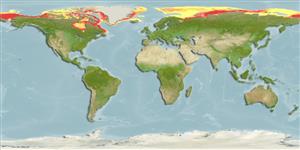Environment: milieu / climate zone / depth range / distribution range
Ecologie
marien; brak water demersaal; diepte 0 - 620 m (Ref. 58426), usually 0 - 100 m (Ref. 9926). Polar; 84°N - 51°N, 180°W - 180°E
Arctic to Northwest Atlantic: Bering Strait to Labrador in Canada. Also found in the estuary of the St. Lawrence River in Canada (Ref. 4926).
Grootte / Gewicht / Leeftijd
Maturity: Lm ? range ? - ? cm
Max length : 16.0 cm TL mannelijk / geslacht onbekend; (Ref. 7251)
Commonly lives in large clusters of kelp (Ref. 7251). It prefers bottom types like pebbles, stones or boulders, mud and sand (Ref. 5951). Benthic species. Feeds on crustaceans (Ref. 58426); especially amphipods (Ref. 5951).
Levenscyclus en paargedrag
Maturiteit | Voortplanting | Paaien | Eieren | Fecunditeit | Larven
Robins, C.R. and G.C. Ray, 1986. A field guide to Atlantic coast fishes of North America. Houghton Mifflin Company, Boston, U.S.A. 354 p. (Ref. 7251)
Status op de Rode Lijst van het IUCN (Ref. 130435)
Gevaar voor de mens
Harmless
Gebruik door de mens
Meer informatie
ReferentiesAquacultuurAquacultuurprofielKweeklijnenGeneticaElectrophoresesErfelijkheidZiektesVerwerkingNutrientsMassaconversie
Tools
Speciale rapporten
Download XML
Internetbronnen
Estimates based on models
Preferred temperature (Ref.
123201): -1.8 - 0.8, mean -1.2 °C (based on 6424 cells).
Fylogenetische diversiteitsindex (Ref.
82804): PD
50 = 0.5000 [Uniqueness, from 0.5 = low to 2.0 = high].
Bayesian length-weight: a=0.01122 (0.00557 - 0.02258), b=3.07 (2.89 - 3.25), in cm total length, based on LWR estimates for this species & (Sub)family-body (Ref.
93245).
Trofisch niveau (Ref.
69278): 3.5 ±0.50 se; based on food items.
Weerstandsvermogen (Ref.
120179): Gemiddeld, minimale populatieverdubbelingstijd 1,4-4,4 jaar (Assuming tmax=3-10).
Fishing Vulnerability (Ref.
59153): Low vulnerability (10 of 100).
